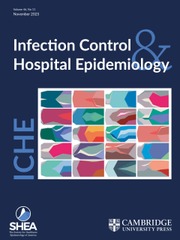Article contents
Cohort Study of the Pathogenesis and Molecular Epidemiology of Catheter-Related Bloodstream Infection in Neonates With Peripherally Inserted Central Venous Catheters
Published online by Cambridge University Press: 02 January 2015
Abstract
To better define the pathogenesis of catheter-related bloodstream infection (BSI) in neonates with peripherally inserted central venous catheters (PICCs) to guide the development of more effective strategies for prevention.
Prospective nested cohort study.
Level III neonatal intensive care unit in a community hospital.
During a randomized trial to assess the safety and efficacy of a prophylactic vancomycin-heparin catheter-lock solution for the prevention of catheter-related BSI in neonates with PICCs, we performed cultures of peripheral and catheter-drawn blood samples, and quantitative cultures of catheter hub samples if BSI was suspected clinically. We performed semiquantitative cultures of the catheter tip and the catheter hub and the skin at the insertion site when the catheter was removed. Molecular subtyping by pulsed-field electrophoresis was used to determine the probable pathogenesis of all BSIs due to coagulase-negative staphylococci (CoNS); for BSIs caused by other microorganisms, epidemiologic concordance was based on speciation and antibiograms. Catheter-related BSI was considered extraluminally acquired if concordance was demonstrable solely between isolates recovered from the catheter tip and the blood, independent of concordance with isolates recovered from the insertion site. Catheter-related BSI was considered intraluminally acquired if concordance was demonstrated only between isolates recovered from the catheter hub and the blood. The source of the infection was considered indeterminate if both concordance patterns were present.
Nosocomial BSI was identified in 23 of the 82 neonates in the cohort. Fifteen of these infections, 14 of which were caused by CoNS, were considered definite or probable catheter-related BSIs. Catheter-related BSI was intraluminally acquired in 10 (67%) of 15 patients, extraluminally acquired in 3 (20%), and indeterminate in 2 (13%).
Most catheter-related BSIs in neonates with PICCs are caused by CoNS and derive from intraluminal contamination. Strategies for prevention of catheter-related BSI directed at this predominant mechanism of infection are most likely to be effective.
Information
- Type
- Original Articles
- Information
- Copyright
- Copyright © The Society for Healthcare Epidemiology of America 2008
References
- 112
- Cited by

